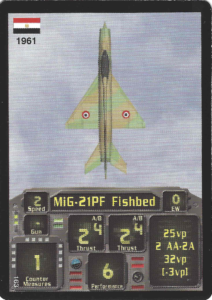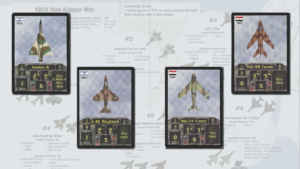Physical Address
304 North Cardinal St.
Dorchester Center, MA 02124
Physical Address
304 North Cardinal St.
Dorchester Center, MA 02124

IN THE HANGAR
Dan Verssen Games (DVG) has long been a true friend to the solitaire wargamer. The “Leader” series, which stretches back to Dan Verssen’s days at GMT Games in 1991 has been a staple of solid, fun games that are fully solitaire, covering everything from World War II fighters (Corsair & Zero Leader) to armored warfare (Tiger and Sherman Leader) to modern jets (Hornet Leader) and ground attack (Thunderbolt-Apache Leader) and the series continues to grow with Stuka Leader having enjoyed a successful Kickstarter campaign earlier this year. And all that is without mentioning the Warfighter Series, the “Commander” series or the more recently added (and outstanding) “Valiant Defense” series. All of ’em – yep, solitaire games.
And while it may seem like everything in the DVG portfolio is solitaire, that is not the case. Among the many other offerings at DVG is the “Down in Flames” series, which like the Leader series, dates back originally to Dan’s GMT days. The first Down in Flames games were World War II era games and the series focuses on the guns-only, piston-engined dogfighting of that global conflict. This is a series of card-driven games and the back-and-forth between the players is fun and the action quick.
In 2018, DVG released “Down in Flames: Locked-On” and that game took the DiF series to the Jet Age. Covering conflicts from the Korean War to the Gulf War, the game includes aircraft models from the early days such as the first American and Soviet built jets to the staples of the end of the Cold War era such as the F-14 Tomcat (of the original “Top Gun” fame), the F-15 Eagle (an aircraft I maintained in my Air Force days and for which I therefore have a great affection, and their Soviet/Russian counterparts such as the MiG-29 and Su-27.
Yet, because it was a two-player game, I never gave it much of a chance. And when it was released to Kickstarter, not all that many others did either. And that, my friends, was a crying shame because this game is, in a word, awesome. Plus, DVG came up with a creative and easy to use method to play it solitaire, making it an instant classic in my book.
PAYLOAD
What’s in the box you might ask? Well, you get a lot, as you might expect in a game covering four-plus decades of aerial combat.
Specifically, what you’ll find inside the box :
What’s not included, and something you’ll need for the solitaire mode, is a single 10-sided die. But if you’re a wargamer, you’ve got plenty of dice around.

The goal in Down in Flames: Locked-On is to get in position to utter either or both of the phrases “Fox one” which means you’re launching a radar-homing missile or “Fox Two” if you’re firing a heat-seeker. Either way, the bandit’s in trouble.
So how does the game play? Does it splash the bogey or is it RTB with bingo fuel?
One thing Dan Verssen has always been able to do is make air combat games that resonate with the drama and feeling of that deadly three-dimensional dance. And the translation from World War II piston-powered planes to supersonic, afterburner-equipped jets works quite well by introducing range to the equation. This is a retrospectively obvious addition as range is important for the missile aspect of modern jet combat. Missiles have ‘envelopes’ in which they can be fired and the pilots attempt to first get into their firing envelope and then get in position to get a lock-on for their radar-homing or heat-seeking missiles.
I played the 1973 Yom Kippur War campaign all the way through before writing this, wanting to get a feel for the solitaire mode. The game is an all-out blast two player with its back-and-forth countering as you play an Ace Pilot card and see your opponent’s hopes of escaping that “Tone” card vanish. The solitaire mode works well, while not being perfect (it is possible to game the system a bit by forcing the “AI” to expend its cards leaving it vulnerable to attacks it can’t counter).

The game is, at its heart, a card-management game, but the cards and mechanics play so well that you forget that what you’re doing is managing your hand. I find myself thinking, “should I barrell roll here, or go for the vertical roll?” – one is easier to counter than the other, so you have to guess what your opponent’s holding, much as a real fighter jock might wonder if his opponent can pull off a specific counter to his maneuvering. There aren’t any G-Forces making your face contort, but there is stress as you hope that card you’re playing is going to get you in position to send a Sidewinder up that MiG’s tailpipe.
The campaign was a blast too. The main reason I chose it was that I knew the Israeli and their Egyptian opponents flew a variety of aircraft. The IAF side featured the Mirage, the Nesher, the F-4 Phantom (another favorite jet of mine) and even an A-4 Skyhawk (a ground attack plane that’s a pretty weak dogfighter) taking on Egyptian MiG-17s, MiG-19s and MiG-21s. I played as Israel, and won the campaign, trying to get in close for a “gun kill” to garner an extra 10 victory points for each MiG I sent spiraling into the desert sands.
The game is just a blast. If you can find an opponent, or three for a 2-on-2 fight, that’s the best way to play. But even playing solitaire this was a fast-moving and thrilling game that will frustrate you at times and at others give you a big thrill when you fire your last missile and it somehow gets through to make the kill that wins the scenario and gives you the campaign too.
You can watch the Yom Kippur campaign on my YouTube channel here.
You can purchase the game from Dan Verssen Games’ website, here.
The first mission in the 1973 Yom Kippur War campaign in Down in Flames: Locked-On from Dan Verssen Games.